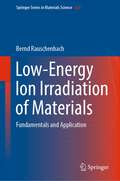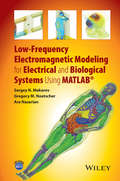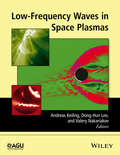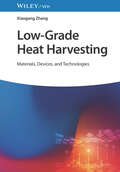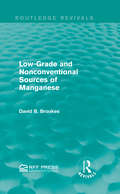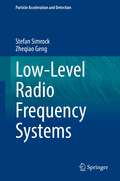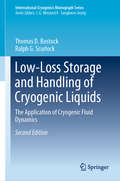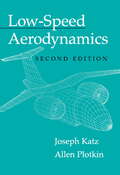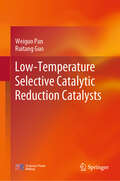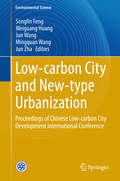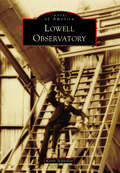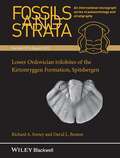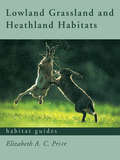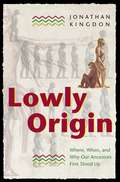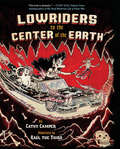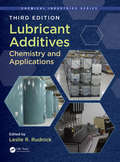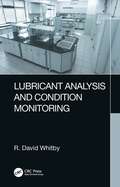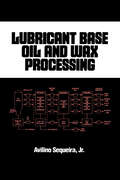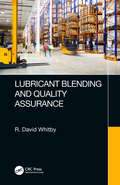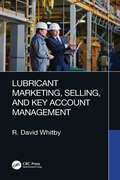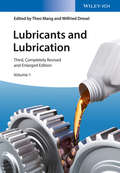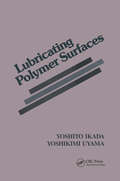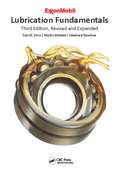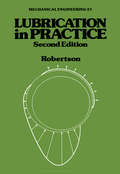- Table View
- List View
Low-Energy Ion Irradiation of Materials: Fundamentals and Application (Springer Series in Materials Science #324)
by Bernd RauschenbachThis book provides a comprehensive introduction to all aspects of low-energy ion–solid interaction from basic principles to advanced applications in materials science. It features a balanced and insightful approach to the fundamentals of the low-energy ion–solid surface interaction, focusing on relevant topics such as interaction potentials, kinetics of binary collisions, ion range, radiation damages, and sputtering. Additionally, the book incorporates key updates reflecting the latest relevant results of modern research on topics such as topography evolution and thin-film deposition under ion bombardment, ion beam figuring and smoothing, generation of nanostructures, and ion beam-controlled glancing angle deposition. Filling a gap of almost 20 years of relevant research activity, this book offers a wealth of information and up-to-date results for graduate students, academic researchers, and industrial scientists working in these areas.
Low-Frequency Electromagnetic Modeling for Electrical and Biological Systems Using MATLAB
by Gregory M. Noetscher Ara Nazarian Sergey N. MakarovProvides a detailed and systematic description of the Method of Moments (Boundary Element Method) for electromagnetic modeling at low frequencies and includes hands-on, application-based MATLAB® modules with user-friendly and intuitive GUI and a highly visualized interactive output. Includes a full-body computational human phantom with over 120 triangular surface meshes extracted from the Visible Human Project® Female dataset of the National library of Medicine and fully compatible with MATLAB® and major commercial FEM/BEM electromagnetic software simulators. This book covers the basic concepts of computational low-frequency electromagnetics in an application-based format and hones the knowledge of these concepts with hands-on MATLAB® modules. The book is divided into five parts. Part 1 discusses low-frequency electromagnetics, basic theory of triangular surface mesh generation, and computational human phantoms. Part 2 covers electrostatics of conductors and dielectrics, and direct current flow. Linear magnetostatics is analyzed in Part 3. Part 4 examines theory and applications of eddy currents. Finally, Part 5 evaluates nonlinear electrostatics. Application examples included in this book cover all major subjects of low-frequency electromagnetic theory. In addition, this book includes complete or summarized analytical solutions to a large number of quasi-static electromagnetic problems. Each Chapter concludes with a summary of the corresponding MATLAB® modules. Combines fundamental electromagnetic theory and application-oriented computation algorithms in the form of stand alone MATLAB® modules Makes use of the three-dimensional Method of Moments (MoM) for static and quasistatic electromagnetic problems Contains a detailed full-body computational human phantom from the Visible Human Project® Female, embedded implant models, and a collection of homogeneous human shells Low-Frequency Electromagnetic Modeling for Electrical and Biological Systems Using MATLAB® is a resource for electrical and biomedical engineering students and practicing researchers, engineers, and medical doctors working on low-frequency modeling and bioelectromagnetic applications.
Low-Frequency Waves in Space Plasmas
by Andreas Keiling Dong-Hun Lee Valery NakariakovLow-frequency waves in space plasmas have been studied for several decades, and our knowledge gain has been incremental with several paradigm-changing leaps forward. In our solar system, such waves occur in the ionospheres and magnetospheres of planets, and around our Moon. They occur in the solar wind, and more recently, they have been confirmed in the Sun's atmosphere as well. The goal of wave research is to understand their generation, their propagation, and their interaction with the surrounding plasma. Low-frequency Waves in Space Plasmas presents a concise and authoritative up-to-date look on where wave research stands.
Low-Grade Heat Harvesting: Materials, Devices, and Technologies
by Xiaogang ZhangLow-Grade Heat Harvesting Harvest a vast untapped reservoir of energy with this essential resource The search for widely available, sustainable energy sources is arguably the defining challenge of the current era. Low-Grade Heat, a term referring to temperatures under 100 degrees Celsius, is an incredibly abundant form of energy in the natural world, but not one which existing sustainable technologies have been able to harvest efficiently and sustainably. The ubiquity of this energy, however, gives it huge potential to address the looming energy crisis. Low-Grade Heat Harvesting surveys existing technologies for utilizing low-grade heat and the related techniques for storing and converting low-grade heat energy. Beginning with the basic thermodynamic principles underlying low-grade heat, it proceeds to work systematically through the major categories of low-grade heat harvesting device, offering a comprehensive overview of the state of the field. Low-Grade Heat Harvesting readers will also find: A focus on emerging technologies Detailed discussion of thermoelectric devices for low-grade heat harvesting, liquid-based thermocells for heat-to-current conversion, and many more Authored by an acknowledged expert in energy storage and conversion Low-Grade Heat Harvesting is ideal for materials scientists, electrochemists, electronics engineers, and anyone else working to address energy needs.
Low-Grade and Nonconventional Sources of Manganese (Routledge Revivals)
by David B. BrookesThis book, first published in 1966, reports the results of a pilot study devoted to understanding the middle-term resource situation for one metal – manganese. Two factors bring the different parts of the manganese supply-demand picture together, one economic and the other political, both of which are examined in detail in this report. Low-Grade and Nonconventional Sources of Manganese will be of interest to students of environmental studies.
Low-Level Radiation and Immune System Damage: An Atomic Era Legacy
by Joseph J. ManganoAtomic weapons and nuclear power plants: they promised to ensure world peace and provide efficient energy to Americans during the 1940s and 1950s. Meanwhile, the post war prosperity led to the most dramatic population explosion ever witnessed in the United States: the "baby boomer" generation.Times and politics may change, but many baby boomers-as well as their descendants-now live with an unforeseen result of the nuclear age. Rates of immune-related diseases have risen steadily throughout the past few decades, from allergies to cancer. While advances in medical care have kept death rates relatively low, the increased prevalence of certain diseases cannot be ignored.Low Level Radiation and Immune System Damage: An Atomic Era Legacy establishes an undeniable connection between the nuclear build up of the past and the widespread health problems seen today. While baby boomers were growing up in the 40s and 50s, above-ground atomic bomb tests and start ups of civilian nuclear power plants were carried out without fear of public exposure to radioactive emissions.Although the consequences of low-level radiation are still hotly debated, Mangano's research findings emphasize a direct link between nuclear exposure and immune system deficiency. In addition to substantial data on immune disease trends among Americans born between the mid-1940s and mid-1960s, Mangano also examines similar issues concerning baby boomer children and grandchildren. Health professionals, environmentalists, historians and students alike will find much to learn from these pages.As America and the world come to terms with the post-Cold War era, there are still many lessons to recognize, consider, and learn from the still-recent past. Low Level Radiation and Immune System Damage: An Atomic Era Legacy explores a relentless trend that will not soon be over-with potential repercussions into the 21st century.
Low-Level Radio Frequency Systems (Particle Acceleration and Detection)
by Stefan Simrock Zheqiao GengThis book begins with an overview of the RF control concepts and strategies. It then introduces RF system models for optimizing the system parameters to satisfy beam requirements and for controller design. In addition to systematically discussing the RF field control algorithms, it presents typical architecture and algorithms for RF signal detection and actuation. Further, the book addresses the analysis of the noise and nonlinearity in LLRF systems to provide a better understanding of the performance of the RF control system and to specify the performance requirements for different parts of the RF system. Today, accelerators require increased RF stability and more complex operation scenarios, such as providing beam for different beam lines with various parameters, and as a result LLRF systems are becoming more critical and complex. This means that LLRF system developers need have extensive knowledge of the entire accelerator complex and a wide range of other areas, including RF and digital signal processing, noise analysis, accelerator physics and systems engineering.Providing a comprehensive introduction to the basic theories, algorithms and technologies, this book enables LLRF system developers to systematically gain the knowledge required to specify, design and implement LLRF systems and integrate them with beam acceleration. It is intended for graduate students, professional engineers and researchers in accelerator physics.
Low-Loss Storage and Handling of Cryogenic Liquids: The Application of Cryogenic Fluid Dynamics (International Cryogenics Monograph Series)
by Ralph G. Scurlock Thomas D. BostockThe revised second edition of this practical book reviews the fundamentals of cryogenic liquid behaviour in small and large scale storage systems. The text is based on research findings on the convective and evaporative behaviour of cryogenic fluids, aimed at improving the design, construction and operation of low-loss cryogenic liquid storage systems, with a view to minimising cost and improving operational safety.Since the first edition was published in 2006, the breadth of cryogenic applications and the modelling of cryogenic fluid dynamics (CFD) have expanded in several directions. In this second edition, most chapters have been extended to introduce discussions of these new applications and their safety and energy economy. These include advances in the modelling of CFD required in, for example, the design of miniature cryocoolers and condensers and reboilers, large-scale cryogenic liquid mixture properties and their stability, and the understanding that hazards and safety problems in the public domain increase with the scaling up of cryogenic systems.With helpful summaries at the end of each chapter, the book is an essential reference for anyone working on the design and operation of cryogenic liquid storage and transportation systems.
Low-Speed Aerodynamics
by Joseph Katz Allen PlotkinLow-Speed Aerodynamics is important in the design and operation of aircraft flying at low Mach number, as well as for ground and marine vehicles. This book offers a modern treatment of the subject, both the theory of inviscid, incompressible, and irrotational aerodynamics and the computational techniques now available to solve complex problems. A unique feature of the text is the computational approach (from a single vortex element to a three-dimensional panel formulation) interwoven throughout. Thus, the reader can learn about classical methods to solve real world aerodynamics problems. This second edition includes a new chapter on the laminar boundary layer, the latest versions of computational technique, and additional coverage of interaction problems. It includes a systematic treatment of two-dimensional panel methods and a detailed presentation of computational techniques for three-dimensional and unsteady flows. With extensive illustrations and examples, this book will be useful for senior and beginning graduate-level courses as well as a useful reference for practicing engineers. Book jacket.
Low-Temperature Selective Catalytic Reduction Catalysts
by Weiguo Pan Ruitang GuoThis book systematically describes the latest research in low-temperature selective catalytic reduction catalysts, providing a theoretical basis and technical support. It first introduces the characteristics and formation mechanism of NOx and presents the control technology of nitrogen oxides at this stage along with the mechanism of low-temperature selective catalytic reduction reactions. In addition, the preparation methods and characterization techniques of these catalysts have been introduced. From this, readers can master the main technical methods required in low-temperature selective catalytic reduction catalyst research. Furthermore, it also covers the anti-poisoning mechanism of Mn-based, Ce-based, Fe-based, Cu-based and low-temperature selective catalytic reduction catalysts, presenting readers with the latest research achievements. Given its scope, this book appeals to a broad readership, particularly professionals at universities as well as engineers engaged in low-temperature selective catalytic reduction fields. It also can be treated as a valuable reference for scholars studying the field.
Low-carbon City and New-type Urbanization
by Jun Wang Weiguang Huang Mingquan Wang Songlin Feng Jun ZhaIn the face of increasingly serious resource and environmental challenges, the world has already accepted low-carbon development as the main way forward for future city construction. Chinese cities have encountered many problems during their development, including land constraints, energy shortages, traffic congestion and air pollution. For this reason, the national meeting of the Central Work Conference on Urbanization made the strategic decision to take a new approach to urbanization and indicated that in future the key features of urbanization in China will be low-carbon development and harmony between the environment and resources. This book discusses the "low-carbon city" as the new pattern of Chinese urbanization. This represents a major change and takes "intensive land use," "intelligent," "green" and "low carbon" as its key words. Low carbon will become an important future development direction for Chinese urbanization development. In the twenty-first Century in response to the global climate change, countries have started a wave of low-carbon city construction. But in China, there are still many disputes and misunderstandings surrounding the issue. Due to a lack of research, low-carbon city construction in China is still in the early stages, and while there have been successes, there have also been failures. There are complex and diverse challenges in applying low-carbon development methods in the context of today's Chinese cities. The construction of low-carbon cities requires efficient government, the technological innovation of enterprises, and professional scholars, but also efforts on the part of the public to change their daily activities. Based on the above considerations, the collection brings together experts from urban planning and design, clean-energy systems, low-carbon transportation, new types of city infrastructure and smart cities etc. , in the hope of forming some solutions for Chinese low-carbon city development.
Lowell Observatory: A History Of Discovery At Flagstaff (Images of America)
by Kevin SchindlerAtop a mesa one mile west of downtown Flagstaff, Arizona, sits Lowell Observatory, an astronomical research facility steeped in tradition. Percival Lowell, scion of a Boston Brahmin family, initially established his observatory in 1894 to study the possibility of intelligent life on Mars. Lowell widely popularized his controversial theories, sparking debate among both the scientific community and lay public. In the following years, the observatory's astronomers made several discoveries that dramatically altered our understanding of space, including Clyde Tombaugh's discovery of Pluto in 1930 and V.M. Slipher's detection of the expanding nature of the universe in 1912. Decades later, Apollo astronauts visited as part of their training to fly to the moon. These stories and others offer a glimpse of the scientific discovery, community pride, and personal triumph that define Lowell Observatory.
Lower Ordovician trilobites of the Kirtonryggen Formation, Spitsbergen: Lower Ordovician Trilobites Of The Kirtonryggen Formation, Spitsbergen (Fossils and Strata Monograph Series #59)
by Richard A. Fortey David L. BrutonThis monograph describes early Ordovician (Ibexian:Tremadocian–early Floian) trilobites from Northern Spitsbergen from the section through the Kirtonryggen Formation adjacent to Hinlopen Strait. The Formation is divided into three Members, each with distinct trilobites collectively representing the fullest known succession from the Bathyurid biofacies of the eastern Laurentian carbonate platform. Previous research on the Ordovician of Spitsbergen is summarised and correlations with similar faunas previously described from Canada, Greenland, western Newfoundland, Vermont–New York State, Oklahoma and Missouri are discussed. Taxonomic problems are discussed in detail leading to the recognition of 53 species, of which 15 are new, belonging to 31 genera including four new. Twenty-four taxa are described under open or tentative nomenclature. The lower Member yields the earliest known occurrences of the Illaenoidea, Proetoidea and Scutelluoidea, supporting the hypotheses relating the origin of new major clades to inshore habitats.
Lowland Grassland and Heathland Habitats (Habitat Guides)
by Elizabeth PriceGrasslands are everywhere: agricultural land, playing fields and road verges; but while species-poor, intensively managed grasslands are widespread, colourful semi-natural grasslands and heathlands, buzzing with life, are scarce. These semi-natural habitats are ancient, cultural landscapes, which are of considerable, if not international importance for biodiversity. However, despite targets for the conservation and restoration of these valuable grasslands and heathlands, these habitats continue to decline before our eyes. Lowland Grassland and Heathland Habitats contrasts the uniformity of intensively managed grassland with the diversity of traditionally managed grasslands and heathlands. It examines topics of concern to the ecologist or habitat manager such as causes of the loss and deterioration of these habitats, including inappropriate management, eutrophication and climate change. It then evaluates opportunities for positive change, such as conservation, restoration and creation. A series of case-studies illustrates the pressures on some lowland grassland and heathland habitat types and looks at ways to enhance them for biodiversity. This habitat guide features illustrated species boxes of typical plants and animals, as well as a full species list, a series of projects on the ecology of grassland and heathland species, a colour plate section, up-to-date references and information, and a full glossary. It will provide students and environmentalists with a deeper understanding of the nature and importance of lowland grasslands and heathlands.
Lowly Origin: Where, When, and Why Our Ancestors First Stood Up
by Jonathan KingdonOur ability to walk on two legs is not only a characteristic human trait but one of the things that made us human in the first place. Once our ancestors could walk on two legs, they began to do many of the things that apes cannot do: cross wide open spaces, manipulate complex tools, communicate with new signal systems, and light fires. Titled after the last two words of Darwin's Descent of Man and written by a leading scholar of human evolution, Lowly Origin is the first book to explain the sources and consequences of bipedalism to a broad audience. Along the way, it accounts for recent fossil discoveries that show us a still incomplete but much bushier family tree than most of us learned about in school. Jonathan Kingdon uses the very latest findings from ecology, biogeography, and paleontology to build a new and up-to-date account of how four-legged apes became two-legged hominins. He describes what it took to get up onto two legs as well as the protracted consequences of that step--some of which led straight to modern humans and others to very different bipeds. This allows him to make sense of recently unearthed evidence suggesting that no fewer than twenty species of humans and hominins have lived and become extinct. Following the evolution of two-legged creatures from our earliest lowly forebears to the present, Kingdon concludes with future options for the last surviving biped. A major new narrative of human evolution, Lowly Origin is the best available account of what it meant--and what it means--to walk on two feet.
Lowriders to the Center of the Earth (Lowriders #2)
by Cathy Camper Raul The ThirdThe lovable trio from the acclaimed Lowriders in Space are back! Lupe Impala, Elirio Malaria, and El Chavo Octopus are living their dream at last. They're the proud owners of their very own garage. But when their beloved cat Genie goes missing, they need to do everything they can to find him. Little do they know the trail will lead them to the realm of Mictlantecuhtli, the Aztec god of the Underworld, who is keeping Genie prisoner! With cool Spanish phrases on every page, a glossary of terms, and an action-packed plot that sneaks in science as well as Aztec lore, Lowriders to the Center of the Earth is a linguistic and visual delight. ¡Que suave!
Lubricant Additives: Chemistry and Applications, Third Edition (Chemical Industries #Vol. 90)
by Leslie R. RudnickThis indispensable book describes lubricant additives, their synthesis, chemistry, and mode of action. All important areas of application are covered, detailing which lubricants are needed for a particular application. Laboratory and field performance data for each application is provided and the design of cost-effective, environmentally friendly technologies is fully explored. This edition includes new chapters on chlorohydrocarbons, foaming chemistry and physics, antifoams for nonaqueous lubricants, hydrogenated styrene–diene viscosity modifiers, alkylated aromatics, and the impact of REACh and GHS on the lubricant industry.
Lubricant Analysis and Condition Monitoring
by R. David WhitbyAlmost all mechanical devices used in every industry require lubrication. Lubricant Analysis and Condition Monitoring explains the benefits of identifying, planning, implementing and using lubricant and machine condition monitoring programmes to extend the lifetimes of both lubricants and machines, to achieve maximum productivity and profitability while reducing impacts on waste and the environment. This book: Offers a comprehensive overview of all types of tests used in lubricant condition monitoring programmes Discusses monitoring the condition of all types of components, machines, equipment and systems used in all industries Considers new and emerging machines, equipment and systems, including electric and hybrid vehicles Suggests which tests to use for each type of machine, equipment or system and, just as importantly, which tests not to use Provides practical examples of how to set up, run and manage condition monitoring programmes and how to achieve significant cost savings through planned and predictive maintenance schedules Gathering vital information that users of lubricants need in one place, this book is of practical use to mechanical, maintenance, manufacturing and marine engineers as well as metallurgists, chemists and maintenance technicians.
Lubricant Base Oil and Wax Processing (Chemical Industries)
by Avilino SequeiraProvides state-of-the-art information on all processes currently used to manufacture lubricant base oils and waxes-offering practical, timesaving solutions for specific on-the-job problems. Furnishes helpful lists of conversion factors, construction cost data, and process licensors, as well as a glossary of essential petroleum processing terms.
Lubricant Blending and Quality Assurance
by R. David WhitbyMany people, including those involved in the manufacturing, marketing and selling of lubricants, believe that blending lubricants is simply a matter of putting one or more base oils and several additives into a tank of some kind and stirring them around to mix them. Blending lubricants that meet customers’ demands requires much more than this. The correct ingredients of the right quality need to be used in precisely controlled quantities. The ingredients need to be tested prior to blending and the finished products need to be tested following blending. The ingredients need to be stored and mixed under carefully controlled conditions. The finished lubricants need to be stored and packaged carefully and then delivered to customers correctly. <P><P>This book discusses all of these issues, describes the different types of equipment used to blend lubricants, provides guidance on how best to use this equipment, and offers tips and techniques to help to avoid problems. It focuses on liquid lubricants. Greases are not discussed, as their manufacture involves very different manufacturing procedures compared with those concerned with liquid lubricants. <P><P>The book starts with descriptions and discussion of the properties and characteristics of the main types of mineral and synthetic base oils, as well as the properties and characteristics of the main types of additives that are used in lubricant formulations. Criteria and methodologies used to design both new and upgraded blending plants are covered next. The types and operation of the equipment used in lubricant blending plants are described and discussed, together with a chapter on how to avoid problems before, during, and after blending. Testing and analysis of base oils, additives, and blended lubricants are covered in two separate chapters. Procedures for quality control and quality management in lubricant blending plants are also discussed in two separate chapters. Types of packages for lubricants are reviewed, together with methods for filling packages and methods for transporting lubricants in bulk. The storage of lubricants and supply chain management is also covered in depth.
Lubricant Marketing, Selling, and Key Account Management
by R. David WhitbyThe global lubricants market exceeds $110 billion, with strong future-estimated annual growth projections. While much has been written about the technical aspects of lubricant development, Lubricant Marketing, Selling, and Key Account Management fills a need for a comprehensive guide on the important commercial aspects of the business, offering unique and valuable insights from a veteran of the industry. It answers questions and offers insights on how to effectively market and sell all types of lubricants, including automotive, industrial, mining, marine, agricultural and aerospace, among others. Covers how and why people and companies buy lubricants. Instructs readers how to research and analyze markets and use the results to plan marketing and sales campaigns and activities. Details how to identify specific target market segments and sell to key lubricant accounts. Discusses how to forecast future demand for lubricants in all types of global markets. This practical book is written for technical and non-technical readers involved in the sale and management of lubricant products and offers hands-on guidance for how to successfully navigate and grow your profitability in this vitally important product sector.
Lubricants and Lubrication, 2 Volume Set
by Mang Wilfried DreselPraise for the previous edition: “Contains something for everyone involved in lubricant technology” — Chemistry & Industry This completely revised third edition incorporates the latest data available and reflects the knowledge of one of the largest companies active in the business. The authors take into account the interdisciplinary character of the field, considering aspects of engineering, materials science, chemistry, health and safety. The result is a volume providing chemists and engineers with a clear interdisciplinary introduction and guide to all major lubricant applications, focusing not only on the various products but also on specific application engineering criteria. A classic reference work, completely revised and updated (approximately 35% new material) focusing on sustainability and the latest developments, technologies and processes of this multi billion dollar business Provides chemists and engineers with a clear interdisciplinary introduction and guide to all major lubricant applications, looking not only at the various products but also at specific application engineering criteria All chapters are updated in terms of environmental and operational safety. New guidelines, such as REACH, recycling alternatives and biodegradable base oils are introduced Discusses the integration of micro- and nano-tribology and lubrication systems Reflects the knowledge of Fuchs Petrolub SE, one of the largest companies active in the lubrication business 2 Volumes wileyonlinelibrary.com/ref/lubricants
Lubricating Polymer Surfaces
by Yoshikimi UyamaA lubricating polymer surface is important, especially in biomedical technologies. Low-friction surfaces enable easy insertion and removal of devices from patients. Earlier approaches were mostly simple applications involving lubricants such as lidocaine jelly, silicone oil, or non-permanent coating with low-friction materials such as polyethylene or fluoroplastics. However, these substances cannot maintain a high degree of slipperiness for the required duration of time. This book describes the principle of lubrication, outlines a variety of methods for attaining a lubricous surface, and describes the characteristics and properties of such lubricous surfaces.
Lubrication Fundamentals, Revised and Expanded
by Don M. Pirro Martin Webster Ekkehard DaschnerCareful selection of the right lubricant(s) is required to keep a machine running smoothly. Lubrication Fundamentals, Third Edition, Revised and Expanded describes the need and design for the many specialized oils and greases used to lubricate machine elements and builds on the tribology and lubrication basics discussed in previous editions. <P><P>Utilizing knowledge from leading experts in the field, the third edition covers new lubrication requirements, crude oil composition and selection, base stock manufacture, lubricant formulation and evaluation, machinery and lubrication fundamentals, and environmental stewardship. The book combines lubrication theory with practical knowledge, and provides many useful illustrations to highlight key industrial, commercial, marine, aviation, and automotive lubricant applications and concepts. All previous edition chapters have been updated to include new technologies, applications, and specifications that have been introduced in the past 15 years. <P><P>What’s New in the Third Edition: <Li>Adds three new chapters on the growing renewable energy application of wind turbines, the impact of lubricants on energy efficiency, and best practice guidelines on establishing an in-service lubricant analysis program <Li>Updates API, SAE, and ACEA engine oil specifications, descriptions of new engine oil tests, impact of engine and fuel technology trends on engine oil <Li>Includes the latest environmental lubricant tests, definitions, and labelling programs <Li>Compiles expert information from ExxonMobil publications and the foremost international equipment builders and industry associations <Li>Covers key influences impacting lubricant formulations and technology <Li>Offers data on global energy demand and interesting statistics such as the worldwide population of nuclear reactors, wind turbines, and output of hydraulic turbines <Li>Presents new sections on the history of synthetic lubricants and hazardous chemical labeling for lubricants <P><P>Whether used as a training guide for industry novices, a textbook for students to understand lubrication principles, or a technical reference for experienced lubrication and tribology professionals, Lubrication Fundamentals, Third Edition, Revised and Expanded is a "must read" for maintenance professionals, lubricant formulators and marketers, chemists, and lubrication, surface, chemical, mechanical, and automotive engineers.
Lubrication in Practice
by W. L. RobertsonThis book will appeal to a broad range of engineers and managers in all sectors of manufacturing engineering, power generation and transport. Drawing on their specialist experience and knowledge, the many contributors show how the careful application of correct lubrication can lead to improved productivity, longer plant and equipment life and higher profits. Throughout the emphasis is on showing what lubricants can do, and how they can best be used. After introductory chapters that summarise the basic theory and the general types and properties of lubricants, there follow eleven chapters that cover such specific applications as diesel and petrol engines, hydraulics, compressors, machine tools and cutting oils. The last two chapters discuss the storage and handling of lubricants, and lubrication planning. The majority of the authors and editors, have worked for Esso Petroleum Company Limited and have a unique range of experience in this area. Many of the authors have contrbuted to advances in techniques for imrproved lubrication in their specialist areas.
